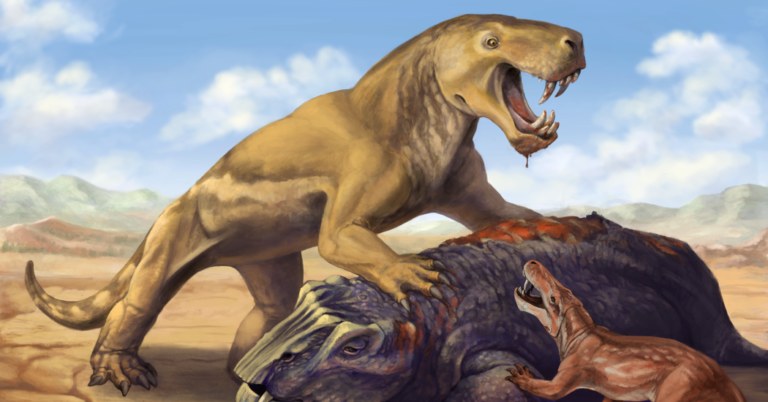Some 252 million years ago, it was a disastrous time to be alive. Erupting supervolcanoes destabilized ecosystems, plunging the planet’s living things into a series of extinctions over the course of a million years and permanently changing life on Earth.
But in what is today southern Africa, some large predators managed to beat the odds for a time. In a paper published Monday in the journal Current Biology researchers describe a new saber-toothed beast that appeared unexpectedly, then vanished, at the very end of the extinction event, challenging the ecological theory that says large predators are first to fall victim to extinction pressures. The discoveries help unlock some of the extinction dynamics of the Permian-Triassic transition, which could be useful in better understanding what may result from the ecological crises faced by life on our planet today.
Life on land throughout the Permian Period, which lasted from about 298 million to 252 million years ago, was dominated by synapsids, the evolutionary precursors to mammals or protomammals. Dinosaurs were more than a hundred million years from evolving.
“Permian synapsids included our own ancestors, and not nearly enough people know about this,” said Christian Kammerer, a research curator and paleontologist at the North Carolina Museum of Natural Sciences and an author of the paper. These synapsids, he added, “are more closely related to us than any dinosaur or other reptile.”
Gorgonopsians were a group within the synapsids. These four-legged carnivores hunted with saber-toothed fangs projecting from a boxy rectangular snout. “They were kind of the T.rex of their time,” said Pia Viglietti, a research scientist at the Field Museum of Natural History and another author of the paper.
Earth’s land mass was then mostly a single Pangea supercontinent. The team discovered that various species of gorgonopsian occupied the top predator niche in what is now Karoo Basin in South Africa throughout the approximately million years of Permian extinction. In an almost factory-line succession, a series of gorgonopsians evolved, filled that niche, went extinct and were then replaced by another.
But what surprised them was the discovery that a gorgonopsian species had evolved and quickly became dominant toward the very end of the Permian extinction. It closely resembled a Siberian tiger-size species, Inostrancevia alexandri, that had previously been found only in Russia.
The two new specimens were discovered by Nthaopa Ntheri and John Nyaphuli in 2010 and 2011 during field work led by Jennifer Botha, a co-author from the University of the Witwatersrand. But it wasn’t until the current team re-examined 77 gorgonopsians fossils from the Karoo that they realized this was a new species. (Mr. Nyaphuli was responsible for numerous significant fossil discoveries, Dr. Viglietti noted, and died in 2020.)
They named the animal Inostrancevia africana, and propose that its forebears migrated from far north to south across the perilous Pangean land mass. When their descendants dominated what became southern Africa, they had no true competitors as they fed on herds of herbivorous Lystrosaurus.
Juan Carlos Cisneros, a paleontologist specializing in the Permian at the Federal University of Piauí in Brazil who was not involved in the research, said that discovering similar gorgonopsians in both Russia and South Africa was “unexpected and exciting.”
“Apparently, what was bad luck for southern predators,” he said, referencing the extinction of gorgonopsian species right before Inostrancevia africana arrived, “ was opportunity for the ones from the north.”
It wasn’t long before Inostrancevia africana faced its own extinction. This discovery, the team emphasizes, offers lessons we should heed.
“What killed the gorgonopsians, and their entire ecosystem,” Dr. Viglietti said, “was a global warming crisis that happened over hundreds of thousands of years.” She noted that in today’s world, “we are seeing these same changes over the course of a single human lifetime.”
Dr. Kammerer also sees the discovery as an opportunity to take another look at the Permian-Triassic Extinction, which is often overlooked in favor of the era of the dinosaurs that followed.
“Without this extinction there is every indication that protomammals would have continued to rule the Earth,” he said, “and the ancestors of dinosaurs might never have had a chance.”



